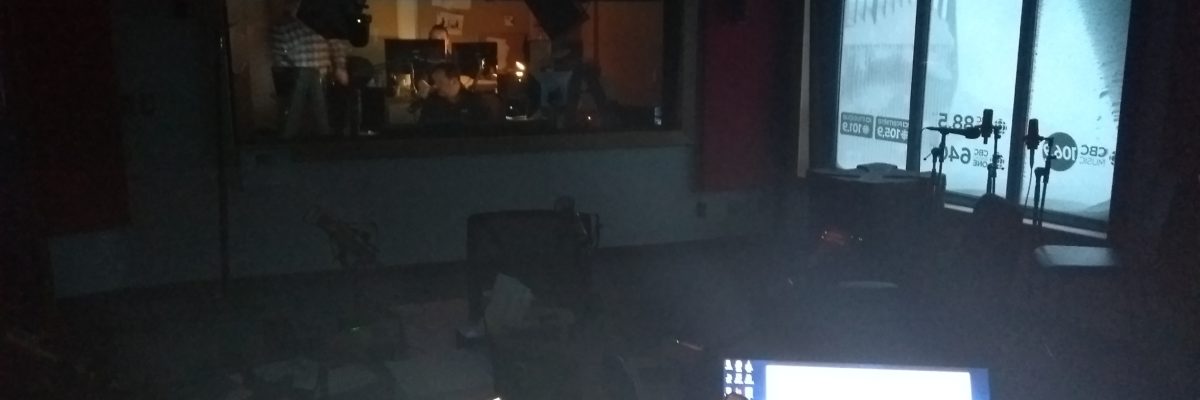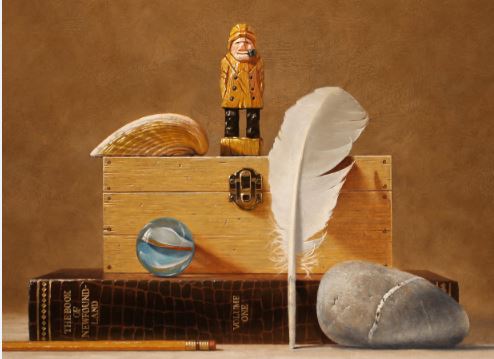The CBC and the SoE
February 2020
During the January 17 blizzard and throughout the subsequent State of Emergency, radio was a lifeline: updating, connecting, advising, informing, and just darn reassuring. The hosts and crew at CBC stayed on the air well past their usual programming times as Snowmageddon roared and the eight-day SoE unfolded. How did they manage it? NQ asked Ted Blades, host of On the Go since 2003, for some insider intel.
How did you get to work during the storm?
We knew a big storm was coming so plans were drawn up on Wednesday and Thursday; who needed to be in the station on Friday; who could work from home or just stay there. The CBC got permission from the city to transport essential staff to the building during the State of Emergency. We were picked up in a 4WD Friday morning and returned home Saturday afternoon. That process was repeated throughout the week of the State of Emergency that followed until taxis were allowed back on the road. I didn’t return to my usual commute until MetroBus returned to service on Monday, January 27th.
Did you have to sleep at the radio station?
Because of the anticipated ferocity of the storm, the CBC didn’t think we’d be able to get home Friday night so 15 rooms were booked at the nearby Guv’nor Inn, on Elizabeth Avenue. That plan fell apart when three members of the early morning team tried to walk to the inn midway through Friday afternoon. They returned to the building within 10 minutes, reporting that they couldn’t even make it out of the CBC parking lot. The winds were simply too strong to make any headway and the flying ice and snow reduced visibility to zero. A short time later another employee set out, wearing snowshoes, a snowmobile suit and goggles. When she returned to the station too, saying she couldn’t make the two blocks to the Guv’nor, I thought, “Well, I guess I’m not getting home tonight!” In the end, 15 of us slept in the station. There were three sofas in the building so the three people who were to be on the air Saturday morning got the luxury suites. The rest of us made beds of blankets and jackets and slept on the floor. But we didn’t get much sleep because many of us stayed up into the early morning hours feeding the overnight broadcast.
Do you have protocol set for a State of Emergency?
I don’t know what the official CBC protocol is. You’ll have to ask management. But from a broadcaster’s point of view, our job is simple: Be on the air. Keep people informed.
How does your programming expand under those circumstances?
The storm was forecast to start sometime after midnight Friday morning and last a full 24 hours into early Saturday so our plan was to pre-empt national programming from 9:00am to noon and 1:00pm to 4:00pm and stay local all day as the storm blew through. The storm’s the story and the question is what do people need to know? On Friday, as the storm raged, our programming focussed on telling the listeners what a state of emergency means: What’s closing that hasn’t already closed; what’s still functioning (hospitals, emergency rooms; the fire and police); who’s lost electricity; what the latest forecast says. In the radio studio, we keep the phone lines open, passing on as much information as we can. Host hands off to host through the day. In the control room, producers take incoming calls and place outgoing calls and put people through to the on air line for the hosts to talk to.
On Saturday, after the storm passed, the focus changes to how are people coping, what are they doing, who needs help, what happens now. This is when radio is at its best and for me – as a radio host – when the job becomes both simple and, at one level, a bit thrilling. Gone is tedious research, or investigation, pre-interviews, and writing scripts and question lines. All you need at that point is the name of the next caller: Joan … where are you? What’s the situation where you are? We stayed in that mode throughout the week of the State of Emergency, keeping the programming day local from 5:30am until 6:30pm
We didn’t return to regular programming, with just the morning, noon, and afternoon shows local until the SoE was lifted.
How do you verify information before sharing it with your audience?
Official information comes from people, organizations and sources we know. Anecdotal information comes from listeners and callers. We take them at face value in a situation like this but often seek a second source.
What is your strongest or favourite memory from the event?
Above all else is the memory of the one time I stepped outside the CBC building on Friday during the height of the storm. I’ve lived in St John’s for 35 years and experienced many a fierce blizzard but never anything like this. The ferocity of the wind, the blinding whiteout, the CBC satellite dish shuddering in the wind. On Saturday, it was the gobsmacking depth of the snow as we made out way home on single track roads.
From a broadcasting point of view, it was the good humour and stoicism of the callers even in the face of historic snowfall. Ready to make do, ready to help out, revelling in the sheer amazingness of it all. As Mark Critch said, it’s the only place where when disaster strikes you want to be there. You don’t want to miss a thing.




